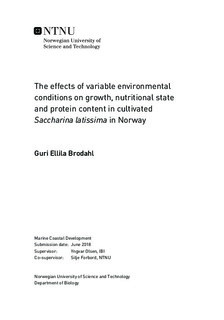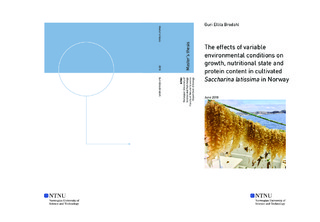| dc.description.abstract | Cultivation of macroalgae, or seaweed, has been a major industry in Asian countries, predominantly China and Indonesia, for decades. Production of seaweed in Norway is mostly related to research and development (R&D), yet some commercial production exists to this date. Saccharina latissima is considered the most promising species for cultivation in Norway due to its ability to grow in a variety of environmental conditions. The aim of this study was to determine differences in growth, internal nitrate and protein content in S. latissima under a variable of environmental conditions and assess patterns in growth rate. A specific question was if internal NO3--N could describe the nutritional state in the algae under study. Young S. latissima sporophytes were deployed at two depths (1-2 m and 8-9 m) at five experimental locations along the Norwegian coast in February of 2017, and sampling of data for growth and chemical analyses occurred during a period of 23 weeks from April to October of 2017. Light and temperature data indicated an earlier seasonal development in the south compared to the north, and a production period reaching over the summer months was found in the north, while loss of biomass occurred during the summer months in the south. The total nitrogen (N) and N:C ratio in S. latissima both decreased early in the experimental period and increased in the end of the period, suggesting that these variables interacted. A similar pattern of variation as for total N and N:C ratio was found for the amino acid residues and protein content at all locations except for the northernmost location. The internal nitrate content was higher in the seedlings (that had been kept in the hatchery in nutrient rich deep water) than in the sporophytes that were cultivated in the sea. A positive, yet not significant, relationship between relative growth rate (RGR) and internal nitrate was found. The seasonal variation in internal nitrate contents in the sporophytes were more clear at the two northern locations than at the three further south. Seasonal variations were clear at the northern locations while the experiment started too late for them to be measured in the south, indicating a latitudinal gradient. Factors such as photosynthetic active radiation and supply of nutrients possibly limited the growth due to natural seasonal fluctuations in the seawater, though a clear factor that affected the growth rate at the different locations was difficult to identify. The nitrogen-to-protein conversion factor was found to be 3.9 ± 0.1, irrespective of cultivation depth, and it was suggested to use this factor if protein determination by amino acids is not available. A comparison of the N:C ratio and internal nitrate content revealed the possibility to introduce internal nitrate as a proxy for the nutritional state of S. latissima in Norway. | |

